Abstract
Trace element accumulation is particularly important in coastal and transitional environments, which act as contaminant buffers between the continental and marine systems. We compared trace element transfer to the biota in two locations with different open-sea exposures in a semi-enclosed marine coastal area (Stagnone di Marsala, Sicily, Italy) using isotopically reconstructed food chains. Samples of sediment, macroalgae, seagrasses, invertebrates, fish, and bird feathers were sampled in July 2006 and analysed for stable carbon and nitrogen isotopes (δ13C, δ15N) and trace elements (arsenic [As], cadmium [Cd], total mercury [THg], and lead [Pb]). Trophic magnification factors were calculated through the relationships between trace elements and δ15N in consumers. As and Pb were greater in organic matter sources (sediments and primary producers), whereas Cd and THg were greater in bird feathers. At the food chain level, an insignificant trophic transfer was found for all elements, suggesting biodilution rather than biomagnification. Sediments were more contaminated in the location with lower open-sea exposure. Macroalgae and seagrasses overall mirrored the spatial pattern highlighted in sediments, whereas differences between the two locations became further decreased moving toward higher trophic levels, indicating that trophic transfer of sediment and macrophyte-bound trace elements to the coastal lagoon food chain may be of relatively minor importance.



Similar content being viewed by others
References
Accornero A, Gnerre R, Manfra L (2008) Sediment concentrations of trace metals in the Berre lagoon (France): an assessment of contamination. Arch Environ Contam Toxicol 54:372–385
Ahearn GA, Mandal PK, Mandal A (2004) Mechanisms of heavy-metal sequestration and detoxification in crustaceans: a review. J Comp Physiol B 174:439–452
Ahlf W, Drost W, Heise S (2009) Incorporation of metal bioavailability into regulatory frameworks—metal exposure in water and sediment. J Soils Sed 9:411–419
Arrontes J (1990) Diet, food preference and digestive efficiency in intertidal isopods inhabiting macroalgae. J Exp Mar Biol Ecol 139:231–249
Barati A (2009) Diet and growth of chicks of the great cormorant, Phalacrocorax carbo, at Ramsar, northern Iran (Ayes: Phalacrocoracidae). Zool Middle East 46:29–36
Barron MG (1990) Bioconcentration: will water-borne organic chemicals accumulate in aquatic animals? Environ Sci Technol 24:1612–1618
Bellucci LG, Frignani M, Paolucci D, Ravanelli M (2002) Distribution of heavy metals in sediments of the Venice Lagoon: the role of the industrial area. Sci Total Environ 295:35–49
Boubonari T, Kevrekidis T, Malea P (2009) Metal (Fe, Zn, Cu, Pb and Cd) concentration patterns in components of a macrophyte-based coastal lagoon ecosystem. Hydrobiologia 635:27–36
Burger J (1993) Metals in avian feathers: bioindicators of environmental pollution. Rev Environ Toxicol 5:203–311
Burton GA Jr, Scott KJ (1992) Sediment toxicity evaluations. Environ Sci Technol 26:2068–2075
Campanella L, Conti ME, Cubadda F, Sucapane C (2001) Trace metals in seagrass, algae and molluscs from an uncontaminated area in the Mediterranean. Environ Pollut 111:117–126
Capiomont A, Piazzi L, Pergent G (2000) Seasonal variations of total mercury in foliar tissues of Posidonia oceanica. J Mar Biol Assoc UK 80:1119–1123
Carabel S, Godínez-Domínguez E, Verísimo P, Fernández L, Freire J (2006) An assessment of sample processing methods for stable isotope analyses of marine food webs. J Exp Mar Ecol Biol 336:254–261
Cheung MS, Wang WX (2008) Analyzing biomagnification of metals in different marine food webs using nitrogen isotopes. Mar Pollut Bull 56:2082–2105
De Lacerda LD (1994) Biogeochemistry of heavy metals in coastal lagoons. In: Kjerfve B (ed) Coastal lagoon processes. Elsevier, Amsterdam, pp 221–241
Dehn L, Follmann E, Thomas D, Sheffield G, Rosa C, Duffy L et al (2006) Trophic relationships in an Arctic food web and implications for trace metal transfer. Sci Total Environ 362:103–123
Dietz R, Riget F, Cleemann M, Aarkrog A, Johansen P, Hansen JC (2000) Comparison of contaminants from different trophic levels and ecosystems. Sci Total Environ 245:221–231
Eeva T, Belskii E, Kuranov B (2006) Environmental pollution affects genetic diversity in wild bird populations. Mutat Res Gen Toxicol Eng 608:8–15
Ferrari I, Chieregato AR (1981) Feeding habits of juvenile stages of Sparus auratus L., Dicentrarchus labrax L. and mugilidae in a brackish embayment of the Po river delta. Aquaculture 25:243–257
Fourqurean JW, Marbà N, Duarte CM, Diaz-Almela E, Ruiz-Halpern S (2007) Spatial and temporal variation in the elemental and stable isotopic content of the seagrasses Posidonia oceanica and C. nodosa from the Illes Balears, Spain. Mar Biol 151:219–232
Franco A, Elliott M, Franzoi P, Torricelli P (2008) Life strategies of fishes in European estuaries: the functional guild approach. Mar Ecol Prog Ser 354:219–228
Gazzetta Ufficiale della Repubblica Italiana (GURI) (2004) Regolamento concernente la fissazione di standard di qualità nell’ambiente acquatico per le sostanze pericolose. DM 367/2003. Ministero dell’Ambiente e della Tutela del Territorio, Roma
Gisbert E, Cardona L, Castellò F (1996) Resource partitioning among planktivorous fish larvae and fry in a Mediterranean coastal lagoon. Estuar Coast Shelf Sci 43:723–735
Holdich DM, Jones JA (1983) Tanaids: keys and notes for the identification of the species. Synopsis of the British fauna. Cambridge University Press, Cambridge, UK
Ikemoto T, Tu NPC, Okuda N, Iwata A, Omori K, Tanabe S et al (2008) Biomagnification of trace elements in the aquatic food web in the Mekong Delta, South Vietnam using stable carbon and nitrogen isotope analysis. Arch Environ Contam Toxicol 54:504–515
Jara-Marini ME, Soto-Jiménez MF, Páez-Osuna F (2009) Trophic relationships and transference of cadmium, copper, lead and zinc in a subtropical coastal lagoon food web from SE Gulf of California. Chemosphere 77:1366–1373
La Loggia G, Calvo S, Ciraolo G, Mazzola A, Pirrotta M, Sarà G et al (2004) Influence of hydrodynamic conditions on the production and fate of Posidonia oceanica in a semi-enclosed shallow basin (Stagnone di Marsala, Western Sicily). Chem Ecol 20:183–201
Lepoint G, Cox AS, Dauby P, Poulicek M, Gobert S (2006) Food sources of two detritivore amphipods associated with the seagrass Posidonia oceanica leaf litter. Mar Biol Res 2:355–365
Liordos V, Goutner V (2009) Sexual differences in the diet of great cormorants Phalacrocorax carbo sinensis wintering in Greece. Eur J Wildlife Res 55:301–308
Marín-Guirao L, Lloret J, Marin A (2008) Carbon and nitrogen stable isotopes and metal concentration in food webs from a mining-impacted coastal lagoon. Sci Total Environ 393:118–130
Mason AZ, Jenkins KD (1995) Metal detoxification in aquatic organisms. In: Tessier A, Turner DR (eds) Metal speciation and bioavailability in aquatic systems. Wiley & Sons, Chichester, pp 479–608
McGeer JC, Brix KV, Skeaff JM, DeForest DK, Brigham SI, Adams WJ et al (2003) Inverse relationship between bioconcentration factor and exposure concentration for metals: implications for hazard assessment of metals in the aquatic environment. Environ Toxicol Chem 22:1017–1037
Mirto S, La Rosa T, Mocciaro G, Costa K, Sarà G, Mazzola A (2004) Meiofauna and benthic microbial biomass in a semi-enclosed Mediterranean marine system (Stagnone of Marsala, Italy). Chem Ecol 20:387–396
Neff JM (2002) Bioaccumulation in marine organisms. Elsevier, Amsterdam
Nfon E, Cousins I, Järvinen O, Mukherjee A, Verta M, Broman D (2009) Trophodynamics of mercury and other trace elements in a pelagic food chain from the Baltic Sea. Sci Total Environ 407:6267–6274
Owens N (1987) Natural variations in 15N in the marine environment. Adv Mar Biol 24:389–451
Peterson B (1999) Stable isotopes as tracers of organic matter input and transfer in benthic food webs: a review. Acta Oecol 20:479–487
Post DM (2002) Using stable isotopes to estimate trophic position: models, methods, and assumptions. Ecology 83:703–718
Reinfelder J, Fisher N, Luoma S, Nichols J, Wang W (1998) Trace element trophic transfer in aquatic organisms: a critique of the kinetic model approach. Sci Total Environ 219:117–135
Reizopoulou S, Nicolaidou A (2004) Benthic diversity of coastal brackish-water lagoons in western Greece. Aquat Conserv Mar Freshwater Ecosyst 14:S93–S102
Ruiz F, Abad M, Olias M, Galan E, Gonzalez I, Aguila E et al (2006) The present environmental scenario of the Nador Lagoon (Morocco). Environ Res 102:215–229
Sayeed I, Ahmad I, Fatima M, Hamid T, Islam F, Raisuddin S (2000) Inhibition of brain Na+, K+ -ATPase activity in freshwater catfish (Channa punctatus Bloch) exposed to paper mill effluent. Bull Environ Contam Toxicol 65:161–167
Schlacher-Hoenlinger MA, Schlacher TA (1998) Differential accumulation patterns of heavy metals among the dominant macrophytes of a Mediterranean seagrass meadow. Chemosphere 37:1511–1519
Storelli MM, Marcotrigiano GO (2001) Heavy metal monitoring in fish, bivalve molluscs, water, and sediments from Varano Lagoon, Italy. Bull Environ Contam Toxicol 66:365–370
Suedel BC, Boraczek JA, Peddicord RK, Clifford PA, Dillon TM (1994) Trophic transfer and biomagnification potential of contaminants in aquatic ecosystems. Rev Environ Contam Toxicol 136:21–89
Szép T, Møller AP, Vallner J, Kovács B, Norman D (2003) Use of trace elements in feathers of sand martin Riparia riparia for identifying moulting areas. J Avian Biol 34:307–320
United States Environmental Protection Agency (1996) Method 3052. Microwave assisted acid digestion of siliceous and organically based matrices. USEPA, Washington, DC
Vizzini S (2000) Caratteristiche dei sedimenti in un’area costiera della Sicilia occidentale (Stagnone di Marsala). Biol Mar Medit 7:524–527
Vizzini S, Mazzola A (2004) The trophic structure of the pipefish community (Pisces: Syngnathidae) from a western Mediterranean seagrass meadow based on stable isotope analysis. Estuaries 27:25–333
Vizzini S, Mazzola A (2005) Feeding ecology of the sand smelt Atherina boyeri (Risso 1810) (Osteichthyes, Atherinidae) in the western Mediterranean: Evidence for spatial variability based on stable carbon and nitrogen isotopes. Environ Biol Fishes 72:259–266
Vizzini S, Mazzola A (2006) Sources and transfer of organic matter in food webs of a Mediterranean coastal environment: evidence for spatial variability. Estuar Coast Shelf Sci 66:459–467
Vizzini S, Sarà G, Michener R, Mazzola A (2002) The role and contribution of the seagrass Posidonia oceanica (L.) Delile organic matter for secondary consumers as revealed by carbon and nitrogen stable isotope analysis. Acta Oecol 23:277–285
Vizzini S, Tramati C, Mazzola A (2010) Comparison of stable isotope composition and inorganic and organic contaminant levels in wild and farmed bluefin tuna, Thunnus thynnus, in the Mediterranean Sea. Chemosphere 78:1236–1243
Wang WX (2002) Interactions of trace metals and different marine food chains. Mar Ecol Progr Ser 243:295–309
Watanabe K, Monaghan MT, Takemon Y, Omura T (2008) Biodilution of heavy metals in a stream macroinvertebrate food web: Evidence from stable isotope analysis. Sci Tot Environ 394:57–67
Acknowledgments
We thank A. Savona for help in the collection of samples, A.E. Aleo for support in stable isotope analysis, and M. Lo Valvo for identification of bird feathers. This study was funded by a PRIN-MIUR Grant and the University of Palermo.
Author information
Authors and Affiliations
Corresponding author
Rights and permissions
About this article
Cite this article
Vizzini, S., Costa, V., Tramati, C. et al. Trophic Transfer of Trace Elements in an Isotopically Constructed Food Chain From a Semi-enclosed Marine Coastal Area (Stagnone di Marsala, Sicily, Mediterranean). Arch Environ Contam Toxicol 65, 642–653 (2013). https://doi.org/10.1007/s00244-013-9933-1
Received:
Accepted:
Published:
Issue Date:
DOI: https://doi.org/10.1007/s00244-013-9933-1




